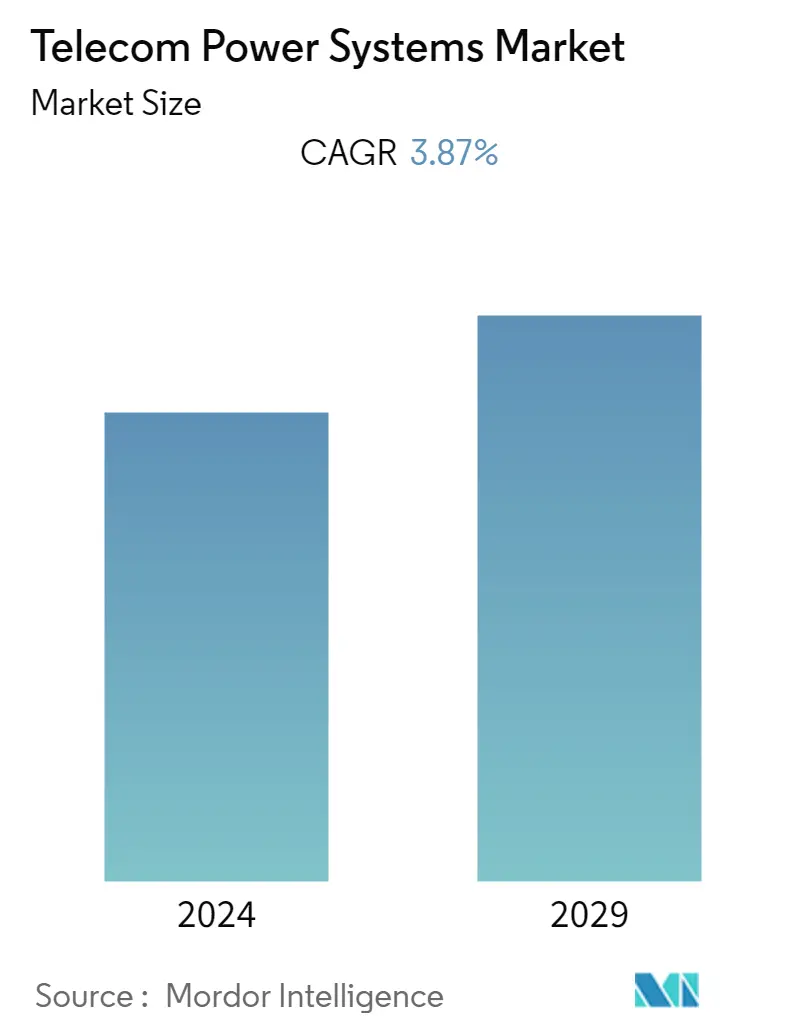Market Size of Telecom Power Systems Industry

| Study Period | 2021 - 2029 |
| Base Year For Estimation | 2023 |
| CAGR | 3.87 % |
| Fastest Growing Market | Asia-Pacific |
| Largest Market | North America |
| Market Concentration | Low |
Major Players
*Disclaimer: Major Players sorted in no particular order |
Need a report that reflects how COVID-19 has impacted this market and its growth?
Telecom Power Systems Market Analysis
The telecom power systems market is expected to register a CAGR of 3.87% over the forecast period. The COVID-19 pandemic led to the growth of broadband traffic, which led to several infrastructure expansion plans by the telecom industry. According to a survey by the GSMA, UK operator BT reported a 100% increase in daytime traffic across its fixed broadband network. Mobile data traffic has declined slightly since before the virus as more people connect to Wi-Fi. On similar lines, Telefonica reported a 35% data increase over its networks in Spain.
- Telecom power systems comprise rectifiers, batteries, and a power system controller, and they secure telecommunication services in case of grid power interruptions and fluctuations. The telecom power systems market has been mostly driven by the fact that more towers are being put up in different parts of the world. This is due to a number of factors, including changing technologies.
- The increasing need for tower installations is driving the market as the following technologies, such as 4G and 5G, are being deployed. Still, the coverage is relatively lower for 4G and 5G technologies in various regions, so telecom companies need to set up more towers to handle the growing voice and data traffic. As technology improves, so does people's need for speed. At first, speed would vary because there wasn't enough coverage, but that's changing now.
- Using solar energy is a steady method of providing electrical power to telecommunication systems in remote places beyond the main electricity grid, for instance, on mountaintops and vast swamps where power is unavailable or it is impractical to install new power lines. This deployment may become a future trend in this market.
- Power outages, especially in developing economies, have been a major roadblock to adopting the latest access technologies. This problem has irritated service providers, cell site operators, and owners all over the world. A new GSMA study says that there could be more than 50 million 5G connections in the MENA region by 2025 and that about 30% of the region's population will be covered by 5G networks by that time.
- Additionally, renewable energy sources for remote telecommunication systems have become more popular recently due to technological advancements and lower costs. Renewable resources, like the wind and the sun, provide useful energy, lower the overall costs of running the system's infrastructure, and leave less of a carbon footprint.
The COVID-19 pandemic also led to the growth of broadband traffic, leading to several infrastructure expansion plans by the telecom industry. According to the International Telecommunication Union (ITU), the increase in traffic due to the COVID-19 pandemic resulted in an acceleration of capital expenditure (CAPEX) via the expansion of capacity (i.e., operations and maintenance CAPEX). The increased capital expenditure has led to a need for new power systems.
